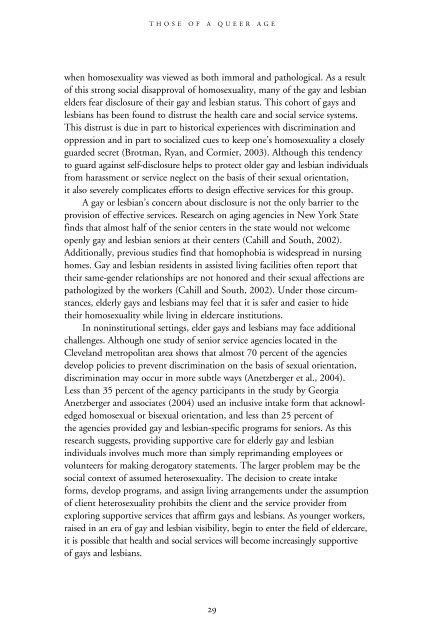2006 - School of Social Service Administration - University of Chicago
2006 - School of Social Service Administration - University of Chicago
2006 - School of Social Service Administration - University of Chicago
Create successful ePaper yourself
Turn your PDF publications into a flip-book with our unique Google optimized e-Paper software.
THOSE OF A QUEER AGE<br />
when homosexuality was viewed as both immoral and pathological. As a result<br />
<strong>of</strong> this strong social disapproval <strong>of</strong> homosexuality, many <strong>of</strong> the gay and lesbian<br />
elders fear disclosure <strong>of</strong> their gay and lesbian status. This cohort <strong>of</strong> gays and<br />
lesbians has been found to distrust the health care and social service systems.<br />
This distrust is due in part to historical experiences with discrimination and<br />
oppression and in part to socialized cues to keep one’s homosexuality a closely<br />
guarded secret (Brotman, Ryan, and Cormier, 2003). Although this tendency<br />
to guard against self-disclosure helps to protect older gay and lesbian individuals<br />
from harassment or service neglect on the basis <strong>of</strong> their sexual orientation,<br />
it also severely complicates efforts to design effective services for this group.<br />
A gay or lesbian’s concern about disclosure is not the only barrier to the<br />
provision <strong>of</strong> effective services. Research on aging agencies in New York State<br />
finds that almost half <strong>of</strong> the senior centers in the state would not welcome<br />
openly gay and lesbian seniors at their centers (Cahill and South, 2002).<br />
Additionally, previous studies find that homophobia is widespread in nursing<br />
homes. Gay and lesbian residents in assisted living facilities <strong>of</strong>ten report that<br />
their same-gender relationships are not honored and their sexual affections are<br />
pathologized by the workers (Cahill and South, 2002). Under those circumstances,<br />
elderly gays and lesbians may feel that it is safer and easier to hide<br />
their homosexuality while living in eldercare institutions.<br />
In noninstitutional settings, elder gays and lesbians may face additional<br />
challenges. Although one study <strong>of</strong> senior service agencies located in the<br />
Cleveland metropolitan area shows that almost 70 percent <strong>of</strong> the agencies<br />
develop policies to prevent discrimination on the basis <strong>of</strong> sexual orientation,<br />
discrimination may occur in more subtle ways (Anetzberger et al., 2004).<br />
Less than 35 percent <strong>of</strong> the agency participants in the study by Georgia<br />
Anetzberger and associates (2004) used an inclusive intake form that acknowledged<br />
homosexual or bisexual orientation, and less than 25 percent <strong>of</strong><br />
the agencies provided gay and lesbian-specific programs for seniors. As this<br />
research suggests, providing supportive care for elderly gay and lesbian<br />
individuals involves much more than simply reprimanding employees or<br />
volunteers for making derogatory statements. The larger problem may be the<br />
social context <strong>of</strong> assumed heterosexuality. The decision to create intake<br />
forms, develop programs, and assign living arrangements under the assumption<br />
<strong>of</strong> client heterosexuality prohibits the client and the service provider from<br />
exploring supportive services that affirm gays and lesbians. As younger workers,<br />
raised in an era <strong>of</strong> gay and lesbian visibility, begin to enter the field <strong>of</strong> eldercare,<br />
it is possible that health and social services will become increasingly supportive<br />
<strong>of</strong> gays and lesbians.<br />
29
















